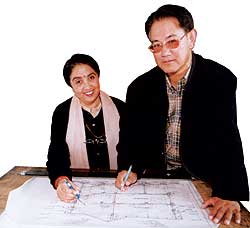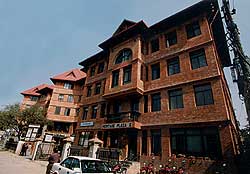 It can be intimidating to design and construct modern buildings in a location like Kathmandu Valley, where centuries of highly refined architecture are still a living presence. Unfortunately, most contemporary and recent constructions just do not cut it, inflicting upon us some of the most hideous and uninspiring concrete blocks this side of the Great Wall.
It can be intimidating to design and construct modern buildings in a location like Kathmandu Valley, where centuries of highly refined architecture are still a living presence. Unfortunately, most contemporary and recent constructions just do not cut it, inflicting upon us some of the most hideous and uninspiring concrete blocks this side of the Great Wall. Which is why, when a building like the Heritage Plaza near Darbar Marg goes up, the more sensitive among us heave a sigh of relief. Not a blind copycat of traditional design, nor an unthinking nod to high modern glass-and steel, its designers Jyoti and Deepak Man Sherchan say the complex represents "eclectically modern design". In this case, the eclecticism derives from integrating an old-world look with new methods of construction and design that address concerns about ensuring efficient and pleasant workspaces that are also environmentally efficient.
Inside the building, the all-exposed brickwork, sloped roof and strutting creates intimate and sometimes surprising spaces without being constrictive"As everything else, the whole game of architecture also has a drama to it," says Deepak Man Sherchan, chairman of Creative Builders Collaborative (CBC), which designed this impressive building and runs a tastefully decorated office there.
It isn't only Deepak Man driving the cart, the other wheel is his wife Jyoti Sherchan, managing director and chief architect of CBC. Deepak designs the aesthetically appealing, yet functional and environmentally sound buildings the collaborative is known for, and Jyoti manages the work at the site and makes the vision take concrete shape. The couple met and tied the knot while teaching at the Engineering Campus two decades ago, but they never thought they'd climb this high on the architectural ladder. "When Deepak left his secure teaching job, we didn't know whether we'd make it or not," say Jyoti.
 But the risk seems to have paid off. The Collaborative is today a well-known firm both at home and outside, as can be seen by the numerous projects that bear their signature. The couple get more than their fair share of work. "We mostly design turn-key key projects, from ground zero to the walk-in phase," says Deepak Man. Among the several awards that they have won, the South Asian Architects Award for the SOS Children's Village in Itahari stands out. Deepak Man has designed and built a dozen or so SOS villages around the country. "When your clients give you a free hand, and let you nurture your project, it becomes your baby till the end. That's one of the reasons why the couple has stopped applying for government contracts. "Of course they're much bigger, challenging and, noticeable, but there's too much interference, and too many hassles," says Deepak Man.
But the risk seems to have paid off. The Collaborative is today a well-known firm both at home and outside, as can be seen by the numerous projects that bear their signature. The couple get more than their fair share of work. "We mostly design turn-key key projects, from ground zero to the walk-in phase," says Deepak Man. Among the several awards that they have won, the South Asian Architects Award for the SOS Children's Village in Itahari stands out. Deepak Man has designed and built a dozen or so SOS villages around the country. "When your clients give you a free hand, and let you nurture your project, it becomes your baby till the end. That's one of the reasons why the couple has stopped applying for government contracts. "Of course they're much bigger, challenging and, noticeable, but there's too much interference, and too many hassles," says Deepak Man. The work CBC does has many admirers, but probably the best indicator of their successful teamwork are the considerable number of architect applicants they get everyday. It is, of course, difficult to accommodate everyone, especially given that they never compromise on quality. "With architects returning from India, the East Bloc countries, and even locally trained in Nepal, there's a bumper harvest of architects-but no new jobs," says Jyoti. "As the investment is low but the returns are high, most colleges have an architecture department. But one can't say that the quality of education is always sound." This quality-or lack thereof-that Jyoti talks about is evident in the large number of tasteless and unsafe high rises that keep cropping up in the Valley. Indeed, only 10 percent of Kathmandu's buildings are actually designed by trained and registered architects, the rest are left to civil engineers or even overseers.
Deepak Man is particularly concerned about this. "There should be more stress on following safety guidelines," he says. "The government should seriously look into all these new high rise structures because if there is an earthquake as big as the one that occurred in 1934, the devastation will be major," he says. (See also "Earthquake coming: waiting for the big one," #25) Reports from surveys conducted by various organisations such as the Kathmandu Valley Earthquake Risk Management Project, the National Society for Earthquake Technology and the Japan International Cooperation Agency confirm these fears.
True, not much can be done about the Valley's old cities, but the local authority could certainly factor in earthquake safety when passing plans for new buildings. Building is an expensive business, but cutting costs at the expense of safety standards cannot possibly be wise. "We should make do with what we have but do it well," warns Deepak Man.
It is a common conceit among architects that they not build houses and offices, but are instrumental in building society at large. For the Sherchans, this is more than idle talk. The couple want to give back to society, and believe that the best way is through education, to ensure a better future for the country. They are investing a lot of time, energy and money in designing and supporting the Malpi International School, something they call a pro-public institution. "It is almost like a co-operative with 50 investors," explains Jyoti. "Rather than send children outside to India to study, we want to retain them here by providing quality education and facilities. After being architects and former lecturers for so long, we need to give back what we've received in education."
After almost a quarter of a century after planning and executing all these plans, have the Sherchans completed their dream project? "For us there is no such thing as a dream project-we only help the client achieve their dream. It is up to them to decide what they want," says Jyoti, while Deepak Man nods. "Still, if you talk about satisfaction and enjoyment the SOS projects have been some of the most best."


